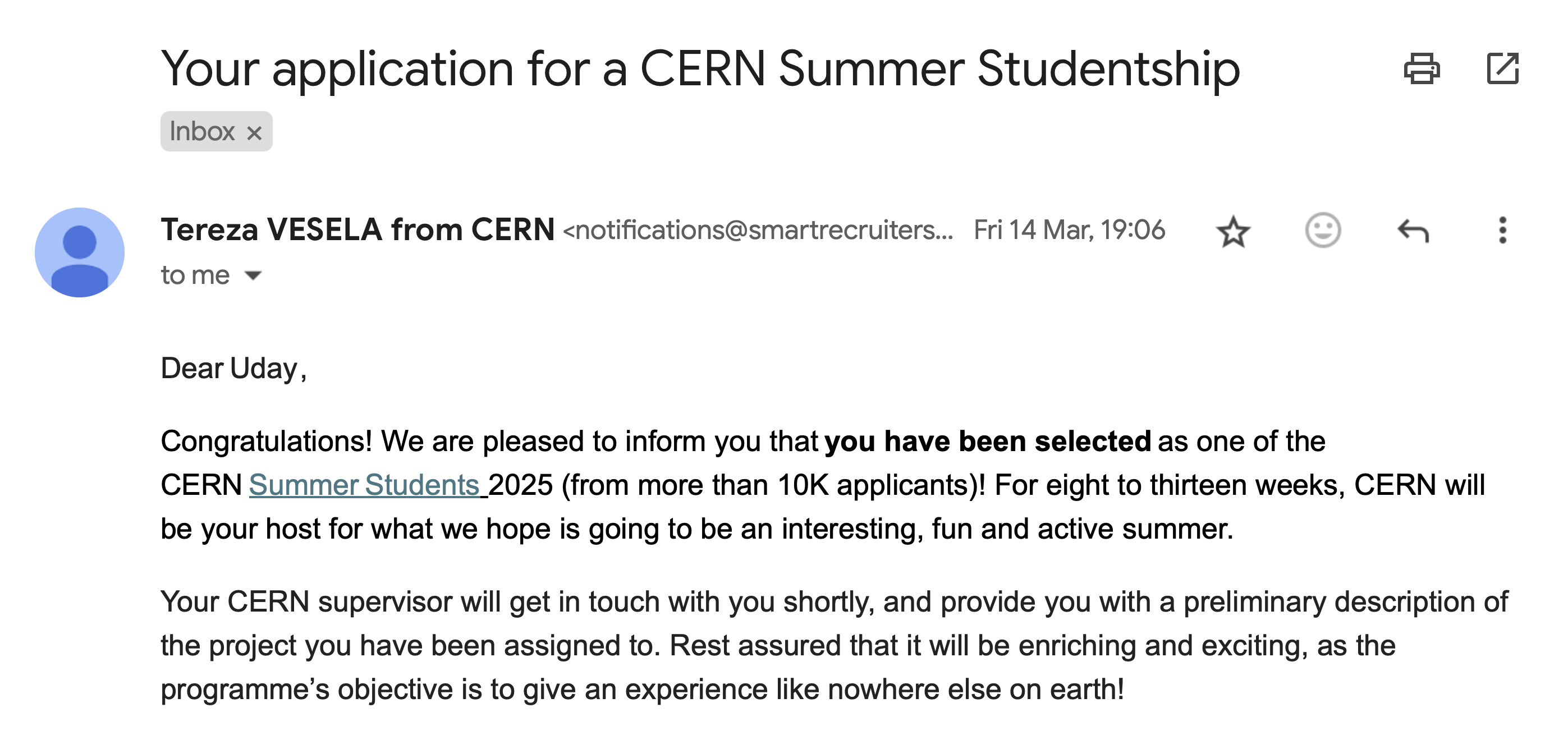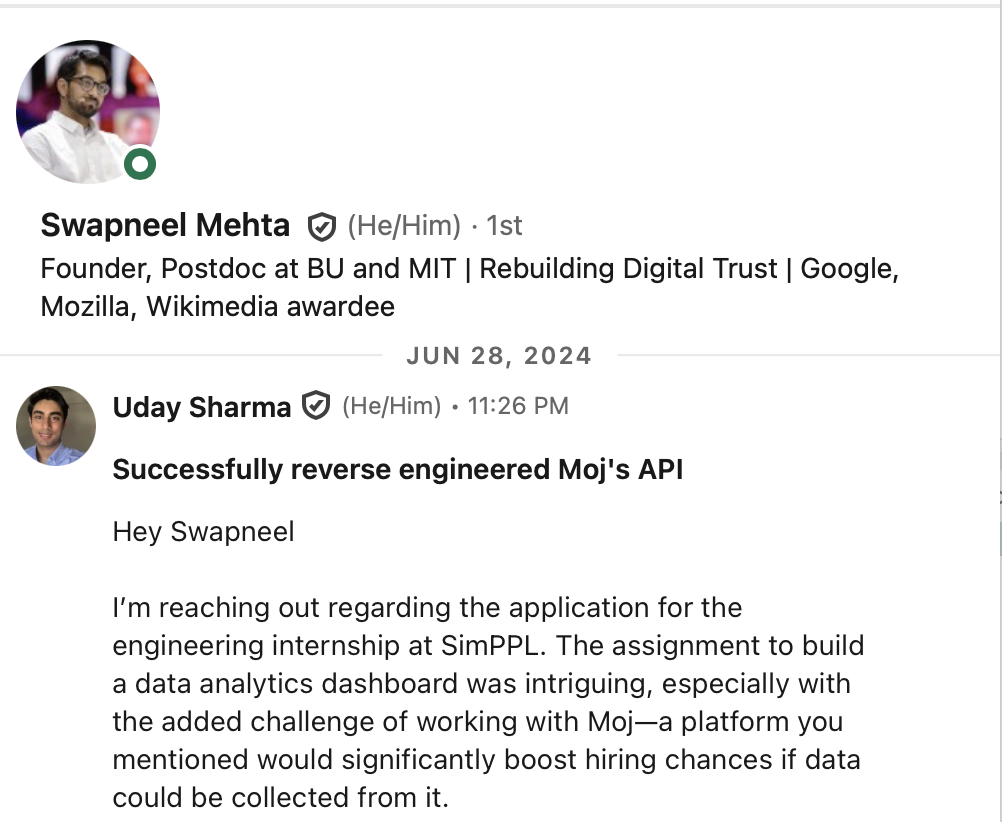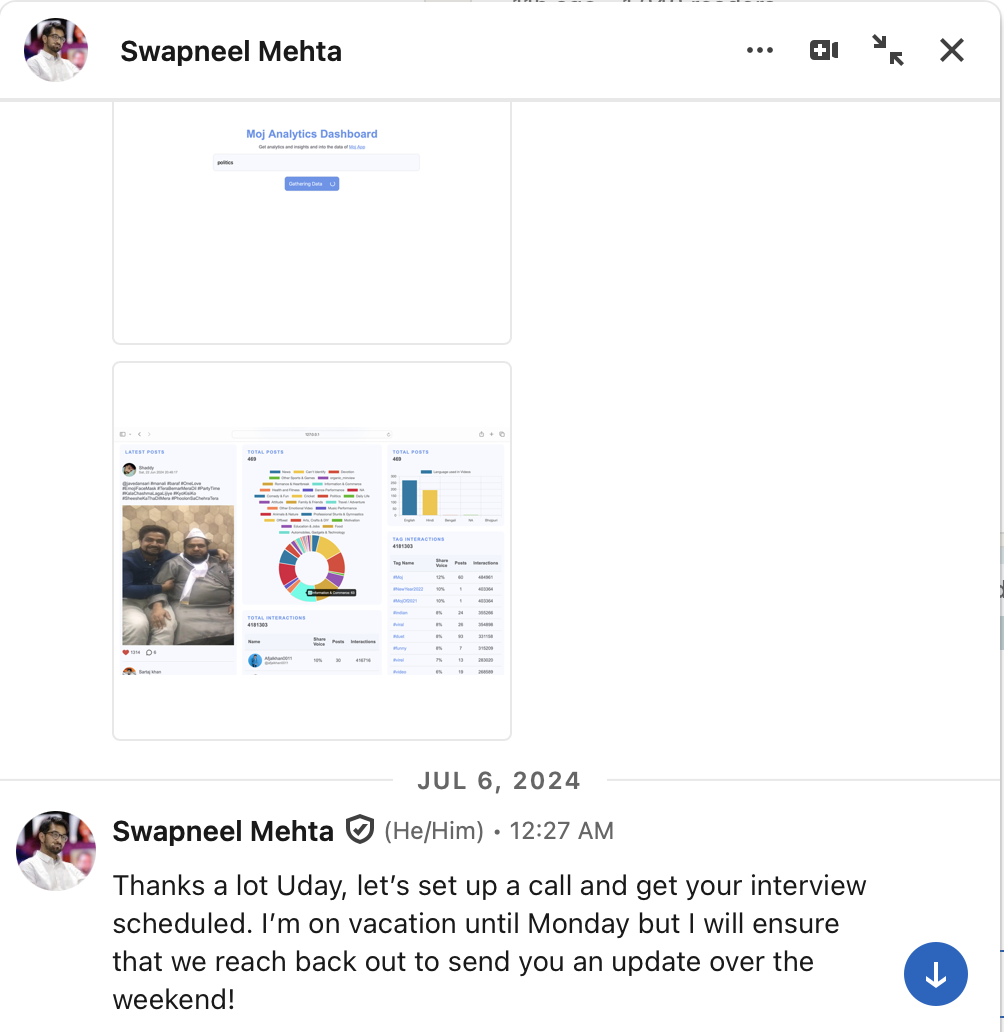From Delhi to Geneva: My Journey to CERN
My journey of how I got selected as a Summer Student at CERN for the batch of 2025 out of 10k people from around the world.
Introduction
CERN or European Organization for Nuclear Research every year invites students from various backgrounds to join the CERN Summer Student Program in Geneva, Switzerland. The program is open to everyone around the world resulting in around 10k applicants in total hence making it very competitive in nature.
People from Member & Associate Member states are given priority; these are countries which provide funding to CERN and in return students from these countries are prioritized to fill certain number of spots in the program. These spots once filled no matter how good you are you won’t be selected.
India is an associate member state and as you can imagine for those few spots you have to put up a tough fight. In 2024, India had 5 spots and for that CERN received 5,273 applications making it an acceptance rate of 0.1%.

Background
I was interested in computers from a young age. I was introduced to programming by a friend of mine named Sujal (shoutout to him) in 9th grade and I loved it. As you can imagine when you love something out of passion you start experimenting and figuring things out, so that’s what I did. I started learning to program using online tutorials and CS50 (thanks David J. Malan), which helped set the base for my love for building stuff. I wasn’t doing this to get an internship or a job—which can make you very tunnel visioned—I was just doing all this out of curiosity.
After school I entered University of Delhi enthusiastically, thinking now I only have to study what I love. I joined Sri Guru Gobind Singh College of Commerce, which is affiliated to the University of Delhi.
I didn’t really have access to technical mentors, role models, or a support system in college to guide me. There weren’t any tech societies, alumni to look up to, or much of a coding culture in general.
So when I came to college, I was pretty disappointed. I had expected to find a group of like-minded people, but that wasn’t the case. I realized early on that I was on my own and would have to figure things out without much help.
I engaged in research activities with one of my professors, Dr. Vandana Kalra, who was working on detecting COVID-19 in lung X-rays using CNNs. This became my first research internship, and after that I went on to work under Dr. Akshay Agarwal at IISER Bhopal in Biometrics. These two research internships helped me lay my foundations in Machine Learning and discover an interest that would later help me find a role that changed the course of my career.
SimPPL: The Inflection Point
Working as a Research Engineer at SimPPL was the holy grail in getting into the CERN Summer Student Program. I remember a good friend of mine, Priyanshi (shoutout to her), applying to a position at SimPPL but not going through with it due to other commitments. She showed me the assignment they had sent her. The assignment said that if someone could get data from Moj (a social media platform), they’d have a 90% chance of getting hired.


As you can imagine, I got onto it—and in 3 days, I reverse-engineered Moj’s API, collected the data, and built a dashboard. After that, I gave the interview for the position of Research Engineer and got selected. This internship taught me more than I could’ve imagined, and I will forever think of it as the primary stepping stone in my career.
The internship brought immense mentorship from two of the best people I’ve met—Dhara and Swapneel (shoutout to them)—who taught me everything from how to present ideas to solving really hard technical problems.
After joining SimPPL, I started working as a solo developer on a project called Arbiter that had been inactive for a while. I dedicated the next 10 months of my life to developing or resurrecting Arbiter from scratch.
I developed data pipelines from multiple social media platforms, optimized these pipelines, created an efficient backend, and integrated it with a frontend. I also built a semantic search infrastructure to search over billions of data points for more accurate social media analysis.
In just four months, I developed the initial MVP and presented a live demo of the platform to Nest fact-checkers and civil society organizations in Mongolia, during capacity-building workshops led by SimPPL in partnership with DW Germany. Soon, instead of being the sole developer, we had a team for the project, and my role evolved into that of Technical Lead—facilitating the integration of features like an AI assistant, in-house topic modeling scatter plots, caching mechanisms for faster results, better storage architecture for large-scale data, and designing efficient database schemas.
Apart from the real-world technical challenges, I also learned soft skills like how to design features without over-engineering simple problems. I also learned how to present to any audience—whether to seasoned engineers or to people who are not technically literate.
I am very grateful for these soft skills I picked up at SimPPL, especially since I had no one before who told me how to ask good questions, design solutions, research topics, and present them—and the best one of all: “what are cc and bcc in an email?” (Thank you, Dhara!).
Applying to CERN: The Vulnerable Truth
My introduction to CERN was through the movie Angels & Demons, and I was fascinated by it—but never thought I’d end up working there. In a one-to-one session with Swapneel, I got introduced to the program since he had also done it during his undergrad. That’s when he told me, “We should help you prepare an application for it.” It was then that I knew I had struck gold in terms of the people around me.
Initially, I believed it was literally impossible to get an international internship without coming from one of the IITs—and especially not being formally trained in Physics. And if I’m being honest, I wasn’t going to apply at all. It was only after Swapneel convinced me that I finally did. I made my application on the last day of the deadline.
On March 7th, I received an email for an interview with a potential supervisor, which made me go crazy with anxiety, since interviews are very rare in the selection process for the Summer Student Program. Over the weekend, I studied everything I could about the project the interview was for—made system design diagrams, read previous years’ student reports for the project, and probably went over my 3-minute introduction at least 100 times, which took me around 12 hours (not kidding).
I got cold feet the night before the interview and was very nervous as this was a very big interview for me. After that, he and I had a long talk, which gave me some clarity. On May 10th, I gave the interview for the position and was very happy with what I said—although I wished I could’ve said a lot more, but time didn’t allow.
Acceptance and What It Means
On May 14th—the day of Holi—I remember vividly, I was sitting in the hall watching some random show when a notification popped up from CERN that said “Congratulations.” It was a moment I’ll remember for the rest of my life and will always cherish.
I got selected out of 10,000 applicants to come to CERN and work on the things I love, which was simply astonishing. When I entered college, I never thought I’d get to attend such a prestigious student program. Working over the summer in Switzerland sounded almost too good to be true.
Over this summer, I’ll be working at CERN in collaboration with the World Health Organization on the NeutrinoReview project, which is a Systematic Review AI Tool aimed at automating literature reviews, under the supervision of Elias Sandner. I hope to gain a lot of exposure working on this project while collaborating with such a diverse team, where people come from all around the world.
While working at CERN, I want to learn how things are done at an organization of such scale—how projects like the LHC are brought to life, and how to carry out research that might change the discourse of humanity’s future. I’m looking forward to collaborating with some of the brightest minds of the 21st century.
How SimPPL Helped me Get here
SimPPL taught me to think outside the box—not just about the technical aspects of development, but also from a product design point of view—which gave me a better perspective. Along with this, they gave me the freedom to test out ideas and experiment with different approaches, which helped me become more dynamic in nature.
Working as a solo developer gave me the confidence to build and ship products and take on the challenges that come with it, like handling bugs in production, testing features, and debugging under pressure. Among other things, I also learned how to work in research–industry collaborations, which helped me build an understanding of Research & Development.
Learning to write was something I was never good at, but this habit was somewhat forced into me—and I’ll be grateful for it throughout my career. I learned how to tell my story better in applications, which ultimately led to my selection in the CERN Summer Student Program.
Advice for Future Applicants
The deadline for the application is in late January, but try to start thinking about your application at least a month before, since the more thought you put into it, the better. At the time, the application only consisted of 4 documents: the application form, resume, motivation letter, and reference letters.
Your resume is the most important part of your application, I believe, since selection is mostly based on whether or not your resume contains the keywords a supervisor searches for while filtering candidates. Think of your resume as the only advocate for your skills—since interviews only happen in rare cases, it’s often the only document that can vouch for you.
Make more than one iteration of your motivation letter and ask someone else to proofread it. Also, informing the person you’re requesting a reference letter from at least a month in advance is the best way—since it gives them time to write you a thoughtful recommendation.
Final Thoughts
Competition for opportunities is increasing day by day, which makes us tunnel-visioned—leading to negative thoughts and a lack of concern for mental health. Try to take care of yourself; everything works out in the end, but mental or physical health takes a lot of time and effort to restore.
Everybody works at their own pace. Try not to reverse-engineer someone else’s career. Instead of chasing binary goals, focus on enjoying the learning process. Just remember—it took Virat Kohli 18 years to say “Ee sala cup namde.”